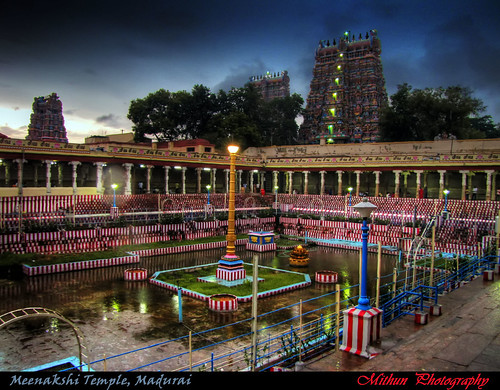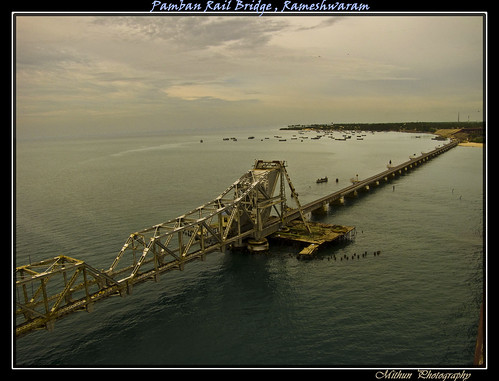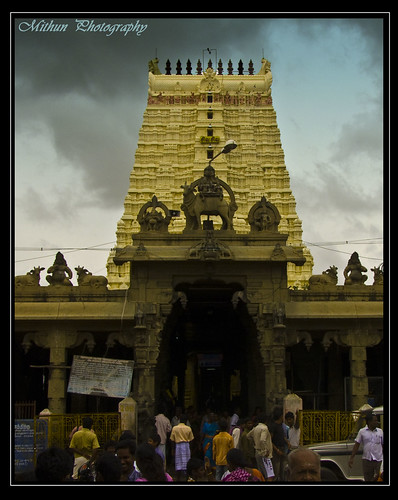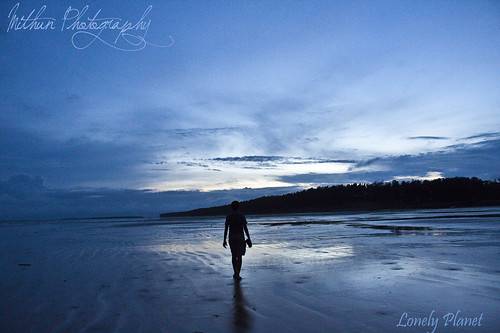Day 1- 9 Sept 2010 – Started from Bangalore Bangalore to Madurai — 9 Hrs / 460KM – NH7
———Little about Madurai ——— Madurai is the oldest continuously inhabited city in the Indian peninsula.It is an ancient and prestigious city in the Indian state of Tamil Nadu, situated on the banks of the River Vaigai in Madurai district. <p$1><p$1>The city is widely known as the Temple City, and is often also referred to as City of four junctions (Koodal Maanagar), Cultural capital of Tamil Nadu (Kalaachaara thalainagar), City of Jasmine (Malligai Maanagar), Sleepless city (Thoonga Nagaram), Athens of the East and The City of Festivals (Thiruvizha nagaram).It is the third largest (was second largest from its origin till 2001) city in Tamil Nadu. <p$1><p$1>Madurai was the capital city of ancient Southern civilization. Madurai’s cultural heritage goes back 2,500 years, and the city has been an important commercial center and has conducted trade as far as Rome and Greece since as early as 550 B.C.E.
—–Starting Journey—–
Started around 9.30A.M. visited lots of temples near & around Madurai.
Weather was cloudy through the journey. Roads are in good condition. So enjoyed a lot.
Alagar Temple
Another Vaishnav temple Alagar Koil,20 km away from the city located in the nearby hills. At the top of the hill is a natural stream from where the water is carried fresh daily by the temple priest for the Lord. Famous for Chittrai Festival(First Tamil month)/9April-May)-Summer Festival. The Lord is considered the brother of Meenakshi (Lordes Paravathi) given in wedding with Sundareshwar (Lord Shiva).
<p$1></p$1>
<p$1></p$1>
<p$1><p$1></p$1></p$1>
<p$1><p$1><p$1><p$1><p$1><p$1> </p$1></p$1></p$1></p$1></p$1></p$1> </p$1></p$1></p$1></p$1></p$1></p$1> |
| <p$1><p$1><p$1><p$1><p$1><p$1>Alagar Temple </p$1></p$1></p$1></p$1></p$1></p$1> |
<p$1></p$1>
<p$1><p$1><p$1><p$1><p$1><p$1> </p$1></p$1></p$1></p$1></p$1></p$1> </p$1></p$1></p$1></p$1></p$1></p$1> |
| <p$1><p$1><p$1><p$1><p$1><p$1>Alagar Temple </p$1></p$1></p$1></p$1></p$1></p$1> |
<p$1></p$1>
<p$1><p$1></p$1></p$1>
<p$1><p$1></p$1></p$1>
<p$1><p$1></p$1></p$1>
<p$1>
<p$1></p$1></p$1>
<p$1>
<p$1>This palace complex was constructed in the Indo-Saracen style by Thirumalai Nayakar in 1636. It is a national monument and is now under the care of the Tamil Nadu Archaeological Department. </p$1></p$1><p$1></p$1><p$1><p$1><p$1><p$1><p$1><p$1><p$1><p$1><p$1><p$1>The original palace complex was four times bigger than the present structure. It was divided into two parts, Swarga-vilasa and Ranga-vilasa. In each of these there are royal residences, theater, shrines, apartments, armory, palanquin place, royal bandstand, quarters, pond and garden. The ceilings are decorated with large paintings showing Shaivite and Vaishnavite themes.</p$1></p$1></p$1></p$1></p$1></p$1></p$1></p$1></p$1></p$1>
<p$1><p$1><p$1><p$1><p$1><p$1>  </p$1></p$1></p$1></p$1></p$1></p$1> </p$1></p$1></p$1></p$1></p$1></p$1> |
<p$1><p$1><p$1><p$1><p$1><p$1>Indo Saracenic Dravidian Architecture</p$1></p$1></p$1></p$1></p$1></p$1> |
<p$1><p$1><p$1><p$1><p$1><p$1><p$1><p$1><p$1><p$1><p$1></p$1></p$1></p$1></p$1></p$1></p$1></p$1></p$1></p$1></p$1></p$1>
<p$1><p$1><p$1><p$1><p$1><p$1> </p$1></p$1></p$1></p$1></p$1></p$1> </p$1></p$1></p$1></p$1></p$1></p$1> |
| <p$1><p$1><p$1><p$1><p$1><p$1>Indo Saracenic Dravidian Architecture</p$1></p$1></p$1></p$1></p$1></p$1> |
<p$1></p$1>
<p$1><p$1><p$1><p$1><p$1><p$1> </p$1></p$1></p$1></p$1></p$1></p$1> </p$1></p$1></p$1></p$1></p$1></p$1> |
| <p$1><p$1><p$1><p$1><p$1><p$1>Ceilling – Indo Saracenic Dravidian Architecture</p$1></p$1></p$1></p$1></p$1></p$1> |
<p$1>The portico known as Swarga Vilasam is an arcaded octagon wholly constructed of bricks and mortar without the support of a single rafter or girder. The stucco work on its domes and arches is remarkable. The gigantic pillars and structures represent architectural mastery. The courtyard and the dancing hall are central attractions for visitors. There are 248 pillars, each 58 feet tall and 5 feet in diameter. Furniture and utensils used by the kings is on exhibit inside the palace. The palace is equipped to perform “Light and Sound” shows depicting the story of “Silappathikaram”, in both Tamil and English languages. The palace is in Indian films such as Bombay, Iruvar, Guru and Jodi. <p$1></p$1></p$1>
<p$1><p$1><p$1><p$1><p$1><p$1> </p$1></p$1></p$1></p$1></p$1></p$1> </p$1></p$1></p$1></p$1></p$1></p$1> |
| <p$1><p$1><p$1><p$1><p$1><p$1>Myself Exploring</p$1></p$1></p$1></p$1></p$1></p$1> |
<p$1>
<p$1><p$1><p$1><p$1><p$1><p$1> </p$1></p$1></p$1></p$1></p$1></p$1> </p$1></p$1></p$1></p$1></p$1></p$1> |
| <p$1><p$1><p$1><p$1><p$1><p$1>The Entrance</p$1></p$1></p$1></p$1></p$1></p$1> |
<p$1><p$1>
<p$1><p$1><p$1><p$1><p$1><p$1> </p$1></p$1></p$1></p$1></p$1></p$1> </p$1></p$1></p$1></p$1></p$1></p$1> |
| <p$1><p$1><p$1><p$1><p$1><p$1>Indo Saracenic Dravidian Architecture</p$1></p$1></p$1></p$1></p$1></p$1> |
<p$1></p$1></p$1></p$1></p$1>
<p$1><p$1><p$1><p$1><p$1><p$1><p$1></p$1></p$1></p$1></p$1></p$1></p$1></p$1>
<p$1><p$1>Once the tank was full of water.That time I can imagine it was pleasure for eye.Now no water. Its became a playground for young stars with lash green field. <p$1><p$1></p$1></p$1></p$1></p$1>
<p$1>Around 1.30 p.m. we finished morning explore. Now its time for Lunch. Be are of-course very hungry & tired also. <p$1>But for people who don’t like South Indian lunch will have hard time to find a place where you can eat. <p$1>We took rest till 5.00 p.m. <p$1>Its time to start again. We have only one destination – the world famous “Meenakshi Amman Temple”. <p$1><p$1>
<p$1>
<p$1>
<p$1>
<p$1>Temple opens 4.30 p.m. at evening & you can visit till 8.00 p.m. <p$1><p$1>We spent almost 3 hours there. Still feel could have spent several hours more.The temple premises is huge and there is every possibility you can be in dilemma where to go & we came from which side. <p$1>We finished puja & brought some memento for parents way back home. Now its time to explore the beauty of the temple. <p$1>Weather was not great.It was raining constantly. So, I don’t more snaps of the temple. <p$1><p$1>
<p$1>
<p$1><p$1>Meenakshi Sundareswarar Temple or Meenakshi Amman Temple Tamil: மீனாட்சி அம்மன் கோவில் is an historic Hindu temple located in the holy city of Madurai, Tamil Nadu, India. It is dedicated to god Shiva – in the form of Sundareswarar or Beautiful Lord– and his consort, Parvati in the form of Meenakshi. The temple forms the heart and lifeline of the 2500 year old city of Madurai. The complex houses 14 magnificent Gopurams or towers including two golden Gopurams for the main deities, that are elaborately sculptured and painted. The temple is a significant symbol for the Tamil people, and has been mentioned since antiquity in Tamil literature, though the present structure is believed to have been built in 1600. The tallest temple tower is 51.9 metres (170 ft) high. <p$1></p$1></p$1></p$1>
<p$1>
<p$1><p$1>
<p$1>
<p$1>Thousand Pillar hall of Madurai Meenakshi Amman temple was built with the oldest Nellaiappar Temple, Tirunelveli as a model. The Aayiram Kaal Mandapam or Thousand Pillar Hall contains 985 (instead of 1000) carved pillars. It is considered culturally important and is maintained by the Archaeological Survey of India. The Thousand Pillared Hall was built by Ariyanatha Mudaliar in 1569. He was the Prime Minister and General of Viswanatha Nayak of the first Nayaka of Madurai (1559-1600 A.D.). He was also the founder of Poligar System, the quasi-feudal organization of the country, which was divided into multiple palayams or small provinces and each palayam was ruled by a palayakkarar or a petty chief. At the entrance of the Mandapam, we can still see his statue; the majestic pose of Ariyanatha Mudaliar seated on a beautiful horse-back which flanks one side of the entrance to the temple. The statue is still periodically crowned with garlands by modern worshippers. Each pillar is carved and is a monument of the Dravidian sculpture. There is a Temple Art Museum in the hall where icons, photographs, drawings, and other exhibits of the 1200 years old history are displayed. Just outside this mandapam, towards the west, are the Musical Pillars. Each pillar, when struck, produces a different musical note. The kalyana mandapa, to the south of the pillared hall, is where the marriage of Shiva and Parvati is celebrated every year during the Chithirai Festival in mid-April. <p$1>
was built by Ariyanatha Mudaliar in 1569. He was the Prime Minister and General of Viswanatha Nayak of the first Nayaka of Madurai (1559-1600 A.D.). He was also the founder of Poligar System, the quasi-feudal organization of the country, which was divided into multiple palayams or small provinces and each palayam was ruled by a palayakkarar or a petty chief. At the entrance of the Mandapam, we can still see his statue; the majestic pose of Ariyanatha Mudaliar seated on a beautiful horse-back which flanks one side of the entrance to the temple. The statue is still periodically crowned with garlands by modern worshippers. Each pillar is carved and is a monument of the Dravidian sculpture. There is a Temple Art Museum in the hall where icons, photographs, drawings, and other exhibits of the 1200 years old history are displayed. Just outside this mandapam, towards the west, are the Musical Pillars. Each pillar, when struck, produces a different musical note. The kalyana mandapa, to the south of the pillared hall, is where the marriage of Shiva and Parvati is celebrated every year during the Chithirai Festival in mid-April. <p$1>
</p$1></p$1></p$1></p$1></p$1></p$1></p$1></p$1></p$1></p$1></p$1></p$1></p$1></p$1></p$1></p$1></p$1></p$1></p$1></p$1></p$1></p$1></p$1><p$1><p$1><p$1><p$1><p$1><p$1><p$1><p$1><p$1><p$1><p$1><p$1><p$1><p$1><p$1><p$1><p$1><p$1><p$1><p$1><p$1><p$1><p$1><p$1><p$1><p$1><p$1><p$1><p$1><p$1><p$1><p$1><p$1><p$1><p$1><p$1><p$1><p$1><p$1><p$1><p$1><p$1><p$1><p$1><p$1><p$1><p$1><p$1><p$1><p$1><p$1><p$1><p$1>Around 8.30p.m. we finished dinner. We need rest. Next way we have to cover huge distance & we need to be ready by 7.30 a.m.</p$1><p$1></p$1><p$1></p$1><p$1><p$1><p$1><p$1><p$1><p$1> </p$1></p$1></p$1></p$1></p$1></p$1></p$1></p$1></p$1></p$1></p$1></p$1></p$1></p$1></p$1></p$1></p$1></p$1></p$1></p$1></p$1></p$1></p$1></p$1></p$1></p$1></p$1></p$1></p$1></p$1></p$1></p$1></p$1></p$1></p$1></p$1></p$1></p$1></p$1></p$1></p$1></p$1></p$1></p$1></p$1></p$1></p$1></p$1></p$1></p$1></p$1></p$1></p$1></p$1></p$1></p$1></p$1></p$1>
<p$1><p$1><p$1><p$1><p$1><p$1><p$1><p$1><p$1><p$1><p$1><p$1><p$1><p$1><p$1><p$1><p$1><p$1><p$1><p$1><p$1><p$1><p$1><p$1><p$1><p$1><p$1><p$1><p$1><p$1><p$1><p$1><p$1><p$1><p$1><p$1><p$1><p$1><p$1><p$1><p$1><p$1><p$1><p$1><p$1><p$1><p$1><p$1><p$1><p$1><p$1><p$1><p$1><p$1><p$1><p$1><p$1><p$1> <p$1><p$1></p$1></p$1></p$1></p$1></p$1></p$1></p$1></p$1></p$1></p$1></p$1></p$1></p$1></p$1><p$1>Madurai to Rameswaram — 4 Hrs / 177 KM – We followed some diversion. So took more time. <p$1>Rameshwaram to KanyRameswaramakumari — 6Hrs 30 Mins / 330 KM <p$1>Road Condition – Excellent <p$1><p$1></p$1></p$1></p$1></p$1></p$1></p$1></p$1></p$1></p$1></p$1></p$1>
<p$1>We woke up early & was prepared by 7.30 a.m.We started exactly at 7.30 a.m. skipped breakfast.In between we had some food from our old stock. Due to some local tension we had to follow diversion. That diverted road was not that great & increased our traveling time by 30 to 45 minutes. <p$1><p$1>During the whole journey our beloved driver Muthu helped us (entertained us) with his “thora thora Hindi”. <p$1><p$1>
<p$1>
<p$1>
<p$1>
<p$1>
<p$1>
<p$1><p$1> <p$1><p$1><p$1>Arround 11.30 a.m. we reached Rameswaram. Our first destination was Ramanathaswamy Temple. <p$1><p$1><p$1>
<p$1>
<p$1><p$1><p$1><p$1><p$1><p$1>———Little about Rameswaram ——— <p$1></p$1></p$1></p$1></p$1></p$1></p$1></p$1>
<p$1></p$1>
<p$1></p$1>
<p$1></p$1>
<p$1></p$1>
—— Ramanathaswamy Temple, Rameswaram ——
<p$1></p$1>
<p$1></p$1>
<p$1></p$1>
<p$1>
</p$1></p$1></p$1></p$1></p$1></p$1>
<p$1>
<p$1>
<p$1>
<p$1>
Pooja procedure
<p$1>
<p$1>
<p$1>
<p$1>
<p$1>
<p$1>
<p$1>
<p$1>
<p$1>
<p$1>
<p$1>
<p$1>
<p$1>
<p$1>
<p$1>
<p$1>
<p$1>
<p$1>
<p$1>
<p$1>
<p$1>
<p$1>
<p$1><p$1><p$1><p$1><p$1><p$1> </p$1></p$1></p$1></p$1></p$1></p$1> </p$1></p$1></p$1></p$1></p$1></p$1> |
| <p$1><p$1><p$1><p$1><p$1><p$1>View from Ram Padyam. The Sky – Sea – Land – Water body – Wind Mill</p$1></p$1></p$1></p$1></p$1></p$1> |
<p$1>
<p$1><p$1><p$1><p$1><p$1><p$1><p$1></p$1></p$1></p$1></p$1></p$1></p$1></p$1></p$1></p$1></p$1></p$1></p$1></p$1></p$1></p$1></p$1></p$1></p$1></p$1></p$1></p$1></p$1></p$1></p$1></p$1></p$1></p$1></p$1></p$1></p$1></p$1></p$1></p$1></p$1></p$1>
<p$1>
<p$1><p$1><p$1><p$1><p$1><p$1></p$1></p$1></p$1></p$1></p$1></p$1>
<p$1><p$1><p$1><p$1><p$1><p$1> </p$1></p$1></p$1></p$1></p$1></p$1> </p$1></p$1></p$1></p$1></p$1></p$1> |
| <p$1><p$1><p$1><p$1><p$1><p$1>View from Ram Padyam . Left Ramnathaswamy Temple , Right Doordarshan Broadcasting antenna.</p$1></p$1></p$1></p$1></p$1></p$1> |
<p$1></p$1><p$1></p$1>
<p$1></p$1>
<p$1>After that we saw the floating stone(Personally I feel those are sporadic corals). We visited Shita & Lakshman Kunda. <p$1>We stopped at Pamban bridge (while coming) to take some snaps.Again I have to mention the place is too good. <p$1>Our driver was in hurry as we need to travel long distance.Now its time for long journey. <p$1><p$1>Rameshwaram to Kanyakumari — 6Hrs 30 Mins / 330 KM <p$1>Road Condition – Excellent <p$1><p$1></p$1></p$1></p$1></p$1></p$1></p$1></p$1></p$1>
<p$1>We started around 4.00 p.m. reached Kanyakumari around 10.45. We were getting board so Antakshari was there. <p$1><p$1>Aroung 6.30 p.m we took some break.Clicked few snaps while having some tea. <p$1><p$1>Finished Dinner & checked into hotel around 11.30 p.m. <p$1><p$1>We were too tired & we need to get up early (5.30 a.m.) next morning. <p$1><p$1><p$1></p$1></p$1></p$1></p$1></p$1></p$1></p$1></p$1></p$1></p$1>
</p$1></p$1><p$1></p$1></p$1>
</p$1></p$1></p$1></p$1></p$1></p$1></p$1></p$1></p$1></p$1></p$1></p$1></p$1></p$1><p$1><p$1><p$1><p$1><p$1><p$1><p$1><p$1><p$1><p$1><p$1><p$1><p$1><p$1>
</p$1></p$1></p$1></p$1></p$1></p$1></p$1></p$1></p$1></p$1></p$1></p$1></p$1></p$1><p$1><p$1><p$1><p$1><p$1><p$1><p$1><p$1><p$1><p$1><p$1><p$1><p$1><p$1>
</p$1></p$1></p$1></p$1></p$1></p$1></p$1></p$1></p$1></p$1></p$1></p$1></p$1></p$1><p$1><p$1><p$1><p$1><p$1><p$1><p$1><p$1><p$1><p$1><p$1><p$1><p$1><p$1>Day 4- 12 Sept 2010 – Exploring Kanyakumar – Travelled from Kanyakumari to Madurai – Madurai to Bangalore</p$1></p$1></p$1></p$1></p$1></p$1></p$1></p$1></p$1></p$1></p$1></p$1></p$1></p$1>
</p$1><p$1>
<p$1>
<p$1><p$1><p$1><p$1><p$1><p$1></p$1></p$1></p$1></p$1></p$1></p$1>
<p$1>Kanyakumari (Tamil: கன்னியாகுமரி) is a town in the Kanyakumari district in the state of Tamil Nadu, India. Located at the southernmost tip of the Indian Peninsula, its former name was Cape Comorin. The closest major cities are Nagercoil, the administrative headquarters of Kanyakumari district, (22 km) and Thiruvananthapuram, the capital of Kerala (85 km). <p$1>Kanyakumari has been a great centre for art and religion for centuries. It was also an area of great trade and commerce. It was ruled by the Cholas, the Cheras, the Pandyas and the Nayaks. The architectural beauty of the temples in the area are the works of these rulers. Later Kanyakumari became part of the Venad kingdom with its capital at Padmanabhapuram. The king of Venad, Anizham Thirunal Marthanda Varma, established Travancore by extending his domain further north up to Azhva, during his reign from 1729 to 1758. By this, the present Kanyakumari District came to be known as Southern Travancore. In 1741, Maharaja Marthanda Varma defeated the Dutch East India Company at the famous Battle of Colachel. <p$1>Kanyakumari was under the rule of the Paravar Kings till the downfall of Pandyas, and later by kings of Travancore under the overall suzerainty of the British until 1947, when India became independent. Travancore joined the independent Indian Union in 1947. The reign of the Travancore royals came to an end. <p$1><p$1><p$1></p$1></p$1></p$1></p$1></p$1></p$1>
<p$1></p$1>
<p$1><p$1></p$1></p$1>
<p$1>Watching the sunrise and sunset is one of the most cherished activities at Kanyakumari. In fact it would not be any exaggeration if we say that this activity has assumed almost a ritualistic proportion. If you are in a hotel your sleep would automatically break at around 5.30 am with the sounds of alarm clock all around. Bleary eyed, you head for the sunrise point or take up a vantage position in the terrace of your hotel building. By 6 am the majestic sight of daybreak unfolds gradually. It is a lifetime experience to observe the image of the night sky metamorphosing bit by bit into various hues of colours. The effect is all the more appealing against the silhouette of fishing boats in the foreground. You can never forget the sun rising above the horizon from the Bay of Bengal. <p$1></p$1></p$1>
<p$1><p$1> <p$1></p$1></p$1></p$1>
<p$1></p$1><p$1><p$1></p$1></p$1>
<p$1>
<p$1><p$1>
<p$1>
<p$1> <p$1>
–Suchindram–<p$1></p$1>
<p$1>
<p$1>
<p$1>
<p$1>
<p$1><p$1><p$1>
<p$1>
<p$1>
<p$1> Vivekananda Rock is about a hundred meters from the shore and a regular ferry service exists between the mainland jetty and the rock. The tickets are Rs 20 for a ride. The Rock has two Mandaps (halls); one belonging to Swami Vivekananda and the other belonging to a Holy Foot. The Holy Foot is a foot shaped carving found on the rock and is believed to be the footprint of Goddess Kumari who stood on this rock on one leg and performed the Tapasya (penance). The Rock memorial has a tall statue of Swami Vivekananda whose photographs are not allowed to be taken from inside the hall. Below the statue was mentioned the year of death of the Swamiji and the “probable” dates when Swamiji attained Samadhi on the rock. Here you can see both sunrise and sunset and it is one of the main tourist attractions here. Golden Hues of the Horizon are very impressive with a silhouette of the Rock Memorial. Timings: 7:30 am to 4:00 pm. You should enter main gate to the jetty for ferry before 4 pm, after that entry is denied. One can stay at the rock even until after sunset. <p$1>
Vivekananda Rock is about a hundred meters from the shore and a regular ferry service exists between the mainland jetty and the rock. The tickets are Rs 20 for a ride. The Rock has two Mandaps (halls); one belonging to Swami Vivekananda and the other belonging to a Holy Foot. The Holy Foot is a foot shaped carving found on the rock and is believed to be the footprint of Goddess Kumari who stood on this rock on one leg and performed the Tapasya (penance). The Rock memorial has a tall statue of Swami Vivekananda whose photographs are not allowed to be taken from inside the hall. Below the statue was mentioned the year of death of the Swamiji and the “probable” dates when Swamiji attained Samadhi on the rock. Here you can see both sunrise and sunset and it is one of the main tourist attractions here. Golden Hues of the Horizon are very impressive with a silhouette of the Rock Memorial. Timings: 7:30 am to 4:00 pm. You should enter main gate to the jetty for ferry before 4 pm, after that entry is denied. One can stay at the rock even until after sunset. <p$1>
<p$1><p$1><p$1> Vivekananda Rock Memorial is a sacred monument and popular tourist attraction in Kanyakumari, India. The memorial stands on one of two rocks located about 500 meters off mainland India’s southernmost tip. It was built in 1970 by the Vivekananda Rock Memorial Committee in honour of the visit of the great spiritual teacher Swami Vivekananda to Shripada Parai during the month of December 1892 for deep meditation and enlightenment. He swam to this rock and meditated about the past, present and future of India. It is said that he attained enlightenment on the rock, and henceforth became a reformer and philosopher. <p$1>From very ancient times, the rock has been regarded as a sacred place. The mythical tradition states that it has been known as ‘Sripada Parai’, meaning the rock that has been blessed by the touch of ‘the sacred feet’ of the Devi Kumari. On the rock is a projection similar in form to a human foot and a little brownish in complexion, which has traditionally been venerated as a symbol of Shripadam. According to legend, it was on this rock that Devi Kumari performed austerity. <p$1>A meditation hall (Dhyana Mandapam) is also attached to the memorial for visitors to meditate. The design of the mandapa incorporates different styles of temple architecture from all over India. It houses a statue of Vivekananda. The merger of three seas – Bay of Bengal, Arabian Sea and Indian Ocean can be seen from these rocks. <p$1>The memorial consists of two main structures, the Vivekananda Mandapam and the Shripada Mandapam. <p$1>
<p$1><p$1>
- Dhyana Mandapam – The meditation Hall with six adjacent rooms
- Sabha Mandapam – The Assembly Hall including Pralima Mandapam (statue section) two rooms, a corridor and an open Prakaram round the Sabha Mandapam
- Mukha Mandapam
- Front Entrance – The steps with two rooms and a corridor below the steps.
<p$1><p$1>
<p$1>
<p$1>
<p$1>Thiruvalluvar Statue is dedicated to arguably the greatest Tamil poet, philosopher, and saint Thiruvalluvar. The rock supports a huge statue of the saint carved out of many rocks that were then joined together. It was inaugurated fairly recently. The statue is about 133 feet long which corresponds to 133 chapters in the greatest epic written by the saint – Thirukkural. Tourists can climb up to the feet of the statue. The view from this point is quite breathtaking! It is a very entertaining and enlightening piece of work and inspires one to lead a very principled and moral life. It is a must read for anyone who visits this place and it is advisable to spend at least half an hour specially dedicated for this exercise. Such is the beauty of Kanyakumari that a lot of people find themselves attracted to it. Mahatma Gandhi too could not resist its charm and there is a place here dedicated to him called Gandhi Mandapam. This is the place, as told by locals, where one could witness the ‘Sangam’ (confluence) of the three oceans! Gandhiji arrived here and succumbed to the beauty of the place as described in his beautiful words inscribed below his portrait in the Mandapam. After he died, his ashes were brought to this place and kept before they were discharged into the sea. The Gandhi Mantapa is engineered in such a way that at the place where the ashes were kept stands a small stone which is said to receive the Sun’s rays only on the 2nd of October, Gandhiji’s birthday, every year through a small hole on the roof. <p$1><p$1>
<p$1>
<p$1>
<p$1>
<p$1>
<p$1>
<p$1> Mahatma Gandhi too could not resist its charm and there is a place here dedicated to him called Gandhi Mandapam. This is the place, as told by locals, where one could witness the ‘Sangam’ (confluence) of the three oceans! Gandhiji arrived here and succumbed to the beauty of the place as described in his beautiful words inscribed below his portrait in the Mandapam. After he died, his ashes were brought to this place and kept before they were discharged into the sea. <p$1><p$1> The memorial site lies in proximity to the famed Kumari Amman temple on the beach; it is a lovely walk from the temple through colorful bazaars. You can pay your tribute to the noble soul anytime between seven in the morning to seven in the evening. <p$1><p$1>
<p$1> Interestingly, the height of the central dome of the memorial is 79 feet, the age of Gandhiji at the time of his assassination. But the most amusing part of the structure is the manner in which it is designed. On 2nd October every year at 12 noon sunlight beams in through a hole in the roof onto the urn that once contained his ashes. Pan through the hall for old photographs that speak volumes about the life and times of the Mahatma. Take the staircase to the terrace for a sweeping view of the sea and the town spanning the shores. Gandhiji had visited Kanyakumari in 1925 and 1937, and completely fell in love with it. Among others the mandapam also houses a few memorabilia that were with him in his last hours. <p$1><p$1><p$1> This place is eminently suited for contemplation. I wish I were to stay here for ever. <p$1><p$1><p$1> <p$1>
<p$1>
<p$1>
<p$1>
<p$1>
<p$1>
<p$1>
<p$1>
<p$1>
<p$1>
<p$1>
<p$1>
<p$1>
</p$1></p$1></p$1></p$1></p$1></p$1>
<p$1>Kanyakumari to Madurai — 5 Hr 30 Min / 270KM <p$1>Madurai – Bangalore – 7 Hr 30 Min / 460 KM <p$1>
<p$1></p$1></p$1></p$1></p$1></p$1></p$1></p$1></p$1></p$1></p$1></p$1></p$1></p$1></p$1></p$1></p$1></p$1></p$1></p$1></p$1></p$1></p$1></p$1></p$1></p$1></p$1></p$1></p$1></p$1></p$1></p$1></p$1></p$1></p$1></p$1></p$1></p$1></p$1></p$1></p$1></p$1></p$1></p$1></p$1></p$1></p$1></p$1></p$1></p$1></p$1></p$1></p$1></p$1></p$1></p$1></p$1></p$1></p$1></p$1></p$1></p$1></p$1></p$1></p$1></p$1></p$1></p$1>
<p$1>
<p$1>
<p$1><p$1>” I am writing this at the cape, in front of the sea, where three waters meet and furnish a sight unequalled in the world. For this reason is no port of call for vessels. Like the Goddess, the waters around are virgin. ” </p$1></p$1></p$1></p$1></p$1></p$1></p$1></p$1></p$1></p$1></p$1></p$1></p$1></p$1></p$1></p$1></p$1></p$1></p$1></p$1></p$1></p$1></p$1></p$1></p$1></p$1></p$1></p$1></p$1></p$1></p$1></p$1></p$1></p$1></p$1></p$1></p$1></p$1></p$1></p$1></p$1></p$1></p$1></p$1></p$1></p$1></p$1></p$1></p$1></p$1></p$1></p$1></p$1></p$1></p$1></p$1></p$1></p$1></p$1></p$1></p$1></p$1>
<p$1><p$1><p$1><p$1><p$1><p$1><p$1><p$1><p$1><p$1><p$1><p$1><p$1><p$1><p$1><p$1><p$1><p$1><p$1><p$1><p$1><p$1><p$1><p$1><p$1><p$1><p$1><p$1><p$1><p$1><p$1><p$1><p$1><p$1><p$1><p$1><p$1><p$1><p$1><p$1><p$1><p$1><p$1><p$1><p$1><p$1><p$1><p$1><p$1><p$1><p$1><p$1><p$1><p$1><p$1><p$1><p$1><p$1><p$1><p$1><p$1><p$1><p$1><p$1><p$1><p$1><p$1><p$1><p$1><p$1><p$1><p$1><p$1></p$1></p$1></p$1></p$1></p$1></p$1></p$1></p$1></p$1></p$1></p$1></p$1></p$1></p$1></p$1></p$1></p$1></p$1></p$1></p$1></p$1></p$1></p$1></p$1></p$1></p$1></p$1></p$1></p$1></p$1></p$1></p$1></p$1></p$1></p$1></p$1></p$1></p$1></p$1></p$1></p$1></p$1></p$1></p$1></p$1></p$1></p$1></p$1></p$1></p$1></p$1></p$1></p$1></p$1></p$1></p$1></p$1></p$1></p$1></p$1></p$1></p$1></p$1></p$1></p$1></p$1></p$1></p$1></p$1></p$1></p$1></p$1></p$1>
Keep following my blog… Will be back soon..

























32 Responses
Excellent hoyechhe Mithun...sabbash
nice..jadio sabta pore uthte parini
great photography... and informative too... will look forward to more such posts...
India is such a wonderful place to travel the adventure tours, Historical monuments, safari tours, Himalayas tracking tours and many more thousands of visitors came across the world to travel India. Travel Packages India .
Excellent Mithun...
Keep rocking..
wow
This comment has been removed by the author.
This comment has been removed by the author.
Interesting blog. It would be great if you can provide more details about it. Thanks you
Rameshwaram Tour Packages
Many thanks for the exciting blog posting! I really enjoyed reading it, you are a brilliant writer. on Cheap Rameshwaram HotelsI actually added your blog to my favorites and will look forward for more updates. Great Job, Keep it up.. 🙂Hotels in Rameshwaram
Thanks for sharing!!
TicketGoose ease the customers to Book Bus Tickets Online through Online Bus Ticket Reservation by walking into its channel partner outlet which includes Corporate Sectors and Ticketing Agents. . TicketGoose is also fast expanding its IT software solutions for private Omni Bus Operators which will enable them to go online and offer their inventory on real time basis
Book Bus Tickets
Thanks For Sharing This Great Post Dude
Plots in Hoskote
A real nice post on Rameshwaram tour which is considered to be extremely holy and sacred by Hindus. To know all the more about Rameshwaram Tour, just log on to: http://easytouristguide.com/sea-beaches/rameshwaram-tour-travelling-to-the-holy-land-of-rama.html
Nice post.
Kanyakumari - one of the most popular tourist destinations of India is famous throughout the world for Vivekananda Rock Memorial. Find Kanyakumari tour details. To know more on Kanyakumari Tour please log on to: http://easytouristguide.com/sea-beaches/kanyakumari-one-of-the-top-10-tourist-spots-of-india.html
This comment has been removed by the author.
This comment has been removed by the author.
This comment has been removed by the author.
This comment has been removed by the author.
This comment has been removed by the author.
This comment has been removed by the author.
This comment has been removed by the author.
This comment has been removed by the author.
Nice places and images also. You have described almost every famous place of Madurai. Still, there is a lot more to the destination with just some of the other charmers being Vaigai Dam, Gandhi Museum, and Thirumalai Nayak Mahal amongst other lovely Madurai places to visit. Check all places to visit in Madurai.
We give treatment for knee pain, vatham joint pain, Head ache, Head tension, single head ache,Neck pain,shouldier pain, back pain, hip pain,foot pain.we give Ayurvedhic oil massage from head to foot.
Visit: http://www.saisiddhavarma.com/
If you come to our Sai Siddha Varma vaithiyasalai,you can relief form this problems. We give u this siddha treatment and varma treatment for your childlessness problems.We can give a wounderful Siddha Ayuirvedha proucts for impotence.
Visit: http://www.saisiddhavarma.com/
Thanks for share this blog….We are tour operator for all over India…
Tour Operators for Kanyakumari
Tour Operators For Ooty
Tour Operators For Kedarnath
Tour Operators For Darjeeling
Hotel Reservations For Shantiniketan
Nice article..
Online Travel Portal
Online Bus Ticket booking
Low Cost Air Tickets Online Booking
Online Hotel Reservations
Holiday Packages India
mobile Bus Ticketing
Online bus Ticket Booking API
flight Booking API
This is awesome! When I recently started solo traveling and blogging, I searched high and low for fellow Indian girls who are traveling on their own to seek guidance and inspiration. Take Self drive car on hire and travel best part of our country. Checkout amazing offers and discount on Self drive car on hire
Wow what an amazing post about your travel experience.I loved reading your travelogue.Thank you for sharing the information. Parveen Travels
Great travel experience and thanks for sharing more information about Madurai. Great time to read this blog. Visit those places by booking your bus tickets in SRSTravels and enjoy your trip.
Its a good blog with good content and beautiful Pictures. Also gathered some needed information From here. Thanks for Sharing.
Madurai to Rameshwaram Cabs Online Cab Booking
Great photography... and informative too... will look forward to more such posts. Madurai to Rameswaram Cabs